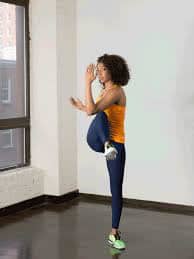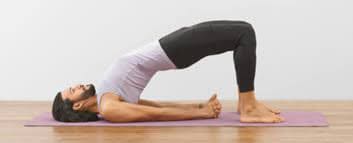
Is that OK??
The answer is it depends!
Pain is very personal. Some of us have experienced a lot of injuries in life from minor trips and falls to more serious events like car accidents. Some of us have endured painful recovery from surgery or giving birth to our children. All of your experiences are mapped on your brain and filed away as a memory.

So, when pain rears its ugly head, our brain has to determine 'HOW BAD IS THIS?' And the way our brain makes that decision is by recalling past experiences and relating them to your current situation. This is not in your control, but what is under your control is what you do when you feel pain.
Here are a few questions to ask yourself if you're experiencing pain or discomfort with exercise:
- 1Can I tolerate this pain for 2-3 more reps?
- 2Does it hurt so bad that I am considering (in that moment) taking pain killers or over-the-counter medication?
- 3If I change my body position, does the pain reduce?
- 4If I decrease the weight or resistance, does the pain reduce?
In healthcare we are taught to use a pain scale from 0-10 (0 = no pain and 10 = the worst pain imaginable). Although this scale is important, it often does not do your pain any justice because a number by itself is just a number without meaning. A different way to think about the pain scale is to use a traffic light metaphor:

PAIN IS PROTECTIVE
Pain does not equal tissue damage. It is not a one-to-one ratio. Pain is our body's natural protective mechanism.
It serves to protect us from injury.
Think of it as your body's smoke alarm: Imagine cooking bacon in the kitchen and the grease gets so hot that it starts to smoke. The smoke alarm alerts you of the smoke.
You are present in your mind and body, actively cooking the bacon, so you know why the alarm is going off.
The first steps you take (if you are like me) are to:
- 1Turn down the stove
- 2Open the window and
- 3Fan the smoke away from the alarm
You don't run out of the house because you are well aware of why the smoke alarm is sounding.
Treat your pain the same way. If you are doing push-ups and your shoulder starts to hurt (rated a yellow on the traffic light) at the bottom of the push-up, then do not go as far down, decrease the range of motion of your push-up and feel if that decreases the shoulder pain.
You know the trigger -- it's the bottom of the push up -- so try to modify the activity.
WHAT IF THE PAIN IS CHRONIC?
Chronic pain is slightly different. When our body experiences unrelenting pain for months or even years on end, then there are proven changes that occur in our brain. Our brain adapts to a new norm and becomes OVER-protective, and not as informative.
Let us take the smoke alarm analogy again; this time the smoke alarm is more sensitive.
You are about to cook the bacon, so you turn on the stove top and open the package when all of a sudden, the alarm gets extremely loud because it detects the heat from the stove.
You respond with intensity and run out of the house! The alarm system did not do its job well, it alerted you, but not for the right reason.
It has lost its ability to gather the right information and therefore has failed in helping you to make an informed decision.
Your personal report of pain on the 0-10 scale and traffic light are likely going to be more sensitive, and that is OK! You will likely have to endure a little more discomfort (in the yellow zone) during physical activity in order to re-acclimate your system back to "normal” and build confidence in your body's ability to adapt.
This takes time, effort, and support.
WHAT IF I HAVE A HIGH TOLERANCE FOR PAIN?
That's fine. You have probably experienced a lot of minor or major injuries and accidents in your life, and so your system, too, has adapted. You likely have a larger library of memories of uncomfortable scenarios that you survived and came out the other side with more confidence about the strength and resilience of your body.
Your system is not over or under protective, it's just right for you and your experiences. Both the 0-10 scale and the traffic light still apply to you. All pain is personal.
PAIN SUMMARY
- 1Pain is protective
- 2Pain does not equal tissue or joint damage
- 3You are in control, use the traffic light and be honest with yourself about HOW uncomfortable you are, don't push through red
- 4If you can tolerate the discomfort, then you can proceed (with some caution)
- 5Our brain adapts to unrelenting chronic pain by becoming MORE sensitive and LESS informative, if this is you, there is hope that you can overcome this, but you will need to work with a professional to get the support and information you need to feel safe and confident with exercise
SAY HELLO! TO GREEN & YELLOW
You are here reading this because you have experienced some level of pain or discomfort with exercise, and you are wondering how to manage it in order to get the outcome you want (whether that outcome is working with a physical therapist or trying to lose the "winter pounds" doesn't matter).
Exercise is positive stress to the body, and the body might respond with a gentle alarm (green & yellow on the traffic light).
The good news is that the human body is incredibly adaptable and responds well to small doses of new and challenging things!
WAYS TO PREPARE YOUR BODY FOR THE STRESS OF EXERCISE

Warming up is not just about getting your heart rate up, it is about exciting your nervous system, waking up your core, and getting your tissues more mobile before you put them under stress.
Most of you probably spend a lot of your day working on a computer. And even if you do a good job of switching from sitting to standing, you have still gotten "rusty" during your workday like the tin man.
So now it’s time to work out. Your body is hungry for movement!
The first thing you should do is warm up: stand up, march in place slowly, do a few mini squats, then arm and neck circles, twist and rotate, get on the floor, and do some cat and cow poses, then a plank or side plank for your core, then some bridges, finally you stand up again and try balancing on one leg, then the other.

In total you just spent about 10 minutes actively moving. Not bad!
Your nervous system is now more awake because you just asked a lot more muscles and joints to move than you have all day in a sitting or standing position. You probably got your heart rate up and can sense that your breathing is a little heavier. Your blood is flowing to parts of your body that have been dormant for a few hours.
Your body is now more prepared for whatever is coming next. The movement preparation can help you get deeper into your poses during your workout or go an extra mile. It also helps get blood flowing to your brain which will help mitigate the pain.
This is just the beginning of exercising completing your warm-up and your body should already be feeling more energized and ready to hit the ground running (or walking)!
Exercise should be enjoyable and FUN! You should leave your workout wanting to come back the next day and challenge your body more.
This all starts with LISTENING to your body, checking in with your traffic light and adjusting as you need.
If you have pain that is keeping you from being as active, stop waiting and email us at getbetter@breakawaypt.com OR call us at 410-721-6333 to schedule your FREE consultation with a licensed physical therapist, your movement experts!
Our bodies crave movement and thrive on being able to use our muscles and joints throughout each day. Listen to your body and let us HELP!
We look forward to hearing from you and guiding you along your road to recovery!



